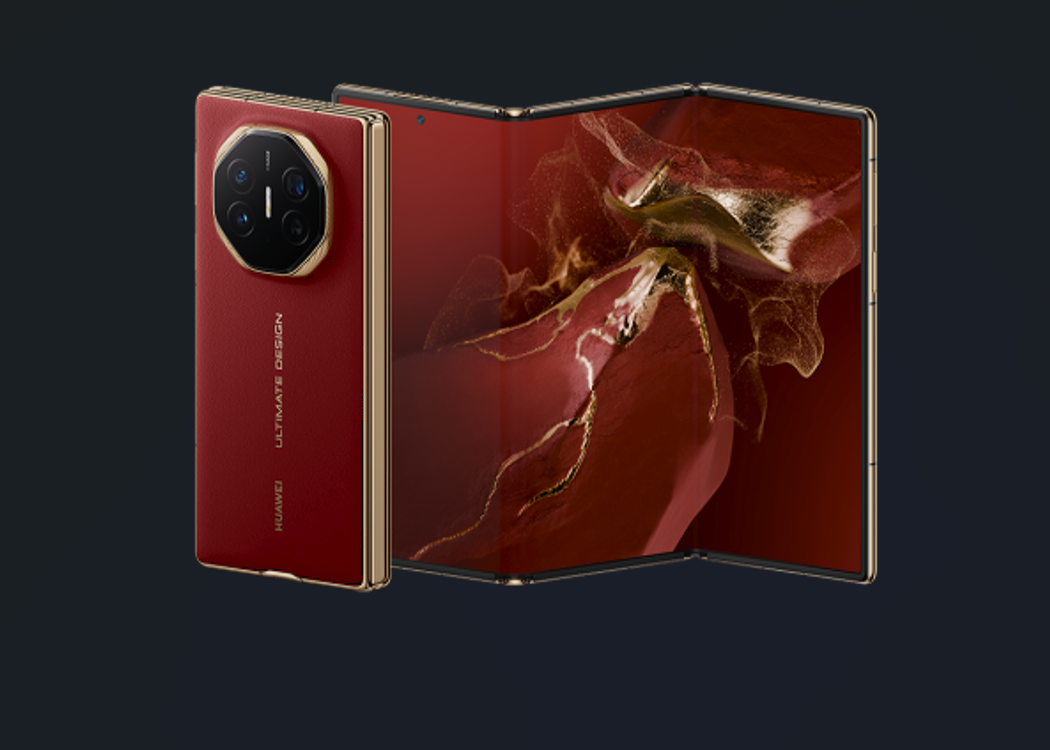Gadget of the Week
Gadget of the Week: Unfolded brilliance in 3 chapters
Huawei’s Mate XT tells the story of foldable smartphones in three screens and three chapters, writes ARTHUR GOLDSTUCK.
What is it?
The Huawei Mate XT is a foldable device that gives us a glimpse of the future of personal devices. As opposed to a ”once upon a time” story, this is a science fiction epic from the worlds of “what if…?”
It is the first tri-fold smartphone, and it could have gone badly wrong, if we recall the tragic tales of the first dual-screen handsets, with peeling screens and eye-peeling prices. The protagonist of this story is elegant, precise, quietly powerful and … beautiful. However, that is how the story ends. Let’s go back to the beginning.
In chapter one, the XT is folded, and it looks like a conventional phone, if slightly thicker than usual. The front display is a bright 6.4-inch OLED panel with slim bezels and rich colour reproduction. With a resolution of 2232 × 1008 pixels, it delivers satisfying high-definition display quality. “Satisfaction” comes up often in this story plot.
What is gets right is a story best told by comparing it to the Samsung Z Fold series. Lying side by side with the 2-screen Fold 6, it appears to solve two problems: each half of the Fold had the thickness of a regular smartphone, making the folded device as bulky as two phones, while its front display had been narrowed to 6.3-inches, making it only just suitable for multitasking. The XT retains the width of a regular handset, at 156.7 x 73.5mm, for a 6.4-inch display, while its 12.8mm bulk – not very far from the Fold’s 12.1mm – has a decent excuse, namely three screens folded into one.
In chapter two, the XT is unfolded once, with the two screens transforming the device into a 7.9-inch near-square tablet. The crease is barely visible, and the display is highly responsive. Huawei’s “Falcon Wing” hinge mechanism is the secret source, thanks to what one could almost call a refined fold, with a smooth, quiet and almost rhythmic action that feels satisfying in a way one does not experience with older foldables. It also feels balanced in the hand, so that one can comfortably use it as a dual-screen device.
This chapter opens with a resolution of 2232 × 2048 pixels, or double that of the single screen, so that the display quality keeps up with the needs of a bigger screen, which demands sharper images and brighter colours.
Triple-screen brilliance
Chapter three delivers the climax of the story, with the XT unfolded in all its triple-screen brilliance. At 219cm wide, it becomes a 10.2-inch, 2232 × 3184 pixel tablet – but a tablet that is a mere 3.6mm thin.
In this true story, the dimensions tell their own tale, so let’s not belabour the plot further. It’s time to dig deeper.
Internally, the Mate XT is powered by Huawei’s Kirin 9000S processor, paired with 12GB of RAM and 512GB of storage.
In the sad prequel to this story, Huawei lost its once-faithful sibling, Google, and had to find its own path in the software world. Doing without Google apps and features is, by now, a given.
This led the story to HarmonyOS, Huawei’s own operating system, which borrows enough from Android for its layout, gestures, and interface design to feel familiar for everyday tasks.
Messaging, streaming, and productivity is fast and intuitive. By having complete control over the software, Huawei has been able to adapt HarmonyOS to foldable multitasking. The result is slick split-screen operation, floating windows that are genuinely useful, and drag-and-drop functionality between apps that makes the most of the large display.
Finally, these features feel like they belong. Watching a video while replying to a message, or comparing two browser tabs side-by-side, is seamless and, yes, satisfyingly natural. The larger phone screen becomes a flexible workspace that adapts to context, and the form factor becomes genuinely productive.
It is almost a plot cliché to say that the Mate XT improves on build quality – it had better, given the demands of the new format. The outer surface is slightly more resistant to smudges and scratches than Huawei’s previous foldables, though it still attracts fingerprints easily. typical of foldables, there is no formal water or dust resistance rating, but overall construction feels solid. The phone’s hinge supports multiple angles, and it stays open without wobble.
And there is time. Battery life, often a weakness of foldables due to the high power demands of large displays, is a pleasant surprise here. The 5600mAh battery tends to last a full day of regular use of the unfolded display, but that diminishes fast with intensive video and gaming use. Fortunately, fast charging is supported at 66W wired and 50W wireless, which puts it ahead of many traditional flagships. That means 85% charge in just over 30 minutes with the right charger. It can also charge other devices, with 7.5W reverse wireless, and 5W reverse wired charging.
The display is, of course, the stand-out character. Both the folded and unfolded screens are sharp, bright, and colour-accurate, with support for HDR10+ and a passable 90Hz refresh rate. The larger 8-inch screen is especially good for reading, browsing, and video playback. Text looks crisp, and colours stay consistent even at odd angles. Creasing is minimal — visible if you go looking for it, but almost unnoticeable during normal use.
The cameras were never going to match up to Huawei’s category-defining Pura70 Ultra, but the triple-lens rear setup is solid, with a 50MP f1.4 wide main sensor, a 12MP ultra-wide, and a 12MP periscope telephoto lens with 5.5x optical zoom. In daylight, the results are consistently strong. Colours are punchy without being oversaturated, and detail retention is good. Low-light photography is improved from earlier foldables, with more accurate exposure and better dynamic range.
But that is only half the camera story, or rather sub-plot. As one would expect from a tri-fold, new photographic options emerge. For example, one can use the main camera system for selfies. By folding the screen back on itself, the rear display becomes a viewfinder, making it possible to take high-quality front-facing photos with all three lenses.
Suddenly, the story takes on new meaning: with such versatility, one begins to sense that one can write one’s own ending to this story.

Photo courtesy Huawei.
How much does it cost?
During April 2025, the Huawei Mate XT has a recommended retail price of R69,999 from the Huawei online store (https://consumer.huawei.com/za/offer/huawei-smartphones/mate-xt-ultimate-design-buy/?cid=5002680), or on contract from cellular operators for between R2,999 and R3,099 a month over 36 months.
Why does it matter?
The Mate XT demonstrates how foldable phones can mature beyond experimental concepts. The hardware feels complete, the software is adapted to the format, and the experience, while still not mainstream, is usable in ways earlier foldables weren’t. It’s a sign that foldables are edging closer to becoming practical choices.
What are the biggest negatives?
- Folded form is still thicker and more awkward than standard smartphones
- Some app compatibility issues persist
- No official IP rating for water or dust resistance
What are the biggest positives?
- Excellent display with minimal creasing and strong colour accuracy
- Well-integrated multitasking and productivity tools
- Solid battery life and fast charging on par with top-tier flagships
* Arthur Goldstuck is CEO of World Wide Worx and editor-in-chief of Gadget.co.za. Follow him on Bluesky on @art2gee.bsky.social.




















